Trees, Shrubs and Woody Vines
Media

Species Types
Scientific Name
Hypericum hypericoides (formerly Ascyrum hypericoides)
Description
St. Andrew’s cross is a small, sprawling shrub up to 3 feet tall, with smooth, opposite leaves, reddish flaky bark, and distinctive yellow flowers with 4 petals. It grows in the southern half of Missouri.
Media
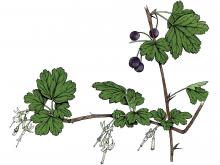
Species Types
Scientific Name
Ribes missouriense
Description
Missouri gooseberry is our state’s most widespread and common gooseberry. People brave its prickly stems to collect its tart, tasty fruits to make pies, jams, and jellies.
Media

Species Types
Scientific Name
Ilex decidua
Description
Possum haw, or deciduous holly, is the more common of two native Missouri hollies that lose their leaves each fall. This shrub or small tree is eye-catching in the fall and winter with its bright red berries.
Media

Species Types
Scientific Name
Celtis occidentalis
Description
Common hackberry is named for its sweet, purple, edible fruits, but most people identify hackberry with its weird-looking bark, which develops numerous corky, wartlike projections and ridges.
Media
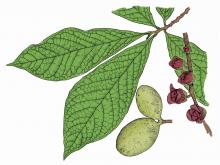
Species Types
Scientific Name
Asimina triloba
Description
“Way down yonder in the pawpaw patch” is an old song you might be familiar with — but today, surprisingly few Missourians know a pawpaw tree when they see one. This is a good tree to know, especially when the large, sweet fruit are ripening!
Media

Species Types
Scientific Name
Diospyros virginiana
Description
Persimmon is best known in the fall, when its orange, plumlike fruits come on. Be careful, however, to make sure a persimmon is ripe before you pop it into your mouth, or you could have a puckery surprise!
Media

Species Types
Scientific Name
Lonicera japonica
Description
Don’t kid yourself about this invasive, exotic vine: Japanese honeysuckle is an aggressive colonizer that shades out native plants and harms natural communities. Learn how to recognize it!
Media
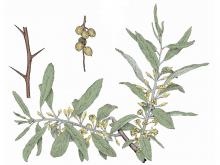
Species Types
Scientific Name
Elaeagnus angustifolia
Description
Russian olive is a small tree with distinctive silvery leaves. It was introduced to America in the late 1800s and widely planted as an ornamental and windbreak. But in many states it has proven to be invasive. It is not recommended here in Missouri.
Media
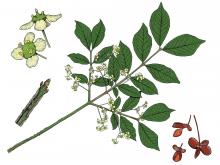
Species Types
Scientific Name
Euonymus alatus
Description
Burning bush, or winged euonymus, is a nonnative shrub that has been very popular in landscaping for its bright red fall foliage. But it is invasive and spreads aggressively into natural habitats, displacing native species.
Media
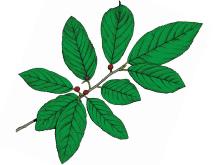
Species Types
Scientific Name
Rhamnus caroliniana (syn. Frangula caroliniana)
Description
Carolina buckthorn occurs in the southeastern half of Missouri. It’s a shrub with several main stems, or a small tree potentially reaching 40 feet high, with a trunk diameter of up to 8 inches. Despite the name, there are no thorns.
See Also
About Trees, Shrubs and Woody Vines in Missouri
There are no sharp dividing lines between trees, shrubs, and woody vines, or even between woody and nonwoody plants. “Wood” is a type of tissue made of cellulose and lignin that many plants develop as they mature — whether they are “woody” or not. Trees are woody plants over 13 feet tall with a single trunk. Shrubs are less than 13 feet tall, with multiple stems. Vines require support or else sprawl over the ground.





















